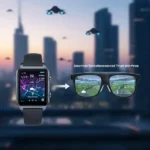Understanding Smart Glasses Safety
Smart glasses, while innovative and beneficial, present several smart glasses safety and health considerations for users. These devices, which are a form of wearable technology, integrate digital information into our field of view, but this convenience comes with potential drawbacks. Understanding these issues is key to safe and effective use.
👓 Common Smart Glasses Safety and Health Concerns
Eye Strain and Digital Eye Fatigue
One of the most common issues with smart glasses is digital eye strain, also known as computer vision syndrome. Staring at a small, close-up digital display for long periods can lead to a number of uncomfortable symptoms.
- Dry Eyes: We tend to blink less when we’re focused on a screen, which can cause our eyes to become dry and irritated.
- Headaches and Blurred Vision: The constant need for our eyes to focus on a nearby object can strain the muscles, leading to headaches and temporary blurred vision.
- Accommodation and Convergence: Smart glasses, similar to smartphones, require your eyes to work harder to focus on the close display, which can lead to fatigue. Studies have shown that smaller display sizes, such as on a smartphone, can cause more severe eye discomfort than larger screens like tablets.
Distraction and Situational Awareness
The ability to receive notifications and see augmented reality overlays can be a major distraction. This is a critical smart glasses safety issue, particularly when engaged in activities that require full attention.
- Driving: A number of studies have found that using a smartphone while driving is distracting and impairs performance. Smart glasses can also be a distraction, even if they allow the user to keep their eyes on the road. The overlay of information can reduce situational awareness and lead to what’s known as “inattentional blindness,” where a person fails to see a visible object or event because their attention is focused elsewhere.
- Walking in Public: Being overly focused on the smart glasses’ display can make a person less aware of their surroundings, increasing the risk of accidents with other pedestrians, vehicles, or obstacles.
Radiation Concerns
Smart glasses, like other electronic devices, emit electromagnetic fields (EMF). The long-term effects of low-level, long-term exposure to these fields, especially from a device worn directly on the head, are a subject of ongoing discussion and research. While the World Health Organization (WHO) has concluded that current evidence does not confirm any adverse health consequences from exposure to low-level EMFs, some gaps in knowledge exist, and research is ongoing.
Physical Discomfort
Prolonged use of smart glasses can also cause physical discomfort.
- Weight and Pressure: The weight of the device, especially if it’s not well-balanced, can cause pressure on the nose, ears, and temples.
- Heat Generation: The internal components can generate heat, leading to discomfort, particularly with extended wear.
- Ergonomics: Improper fit can lead to neck strain and poor posture. Choosing a lightweight, adjustable design is essential for comfort and long-term use.
Best Use Cases for Smart Glasses Safety
Despite the health and safety issues, smart glasses have incredible potential when used appropriately.
- Industrial and Manufacturing: In settings like warehouses and factories, smart glasses enable “pick-by-vision” systems, which can significantly boost efficiency and reduce errors. They provide workers with hands-free access to instructions, checklists, and data, increasing safety and productivity.
- Healthcare: Smart glasses are revolutionizing healthcare by providing surgeons with augmented reality overlays of patient data during operations, improving surgical precision. They are also used for remote consultations, allowing specialists to guide local practitioners in real-time, and for medical education, giving students an immersive, first-person view of procedures.
- Education and Training: Smart glasses can offer interactive and immersive learning experiences, from virtual anatomy lessons to training simulations for complex tasks.
Troubleshooting Common Problems
- Eye Strain: If you’re experiencing eye strain, try the 20-20-20 rule: every 20 minutes, look at an object at least 20 feet away for at least 20 seconds. Blink frequently and use artificial tears if your eyes feel dry. Adjusting the screen brightness and text size can also help.
- Connection Issues: If your glasses aren’t connecting to your phone, make sure they are charged, turned on, and that Bluetooth is enabled on your phone. Move closer to the phone and disconnect any other Bluetooth devices.
- Physical Discomfort: If the glasses feel uncomfortable, try adjusting the fit. Ensure the weight is evenly distributed and take breaks to rest your face and neck.
Frequently Asked Questions (FAQ) About Smart Glasses Safety
Q: Are smart glasses safe for children?
A: Manufacturers often provide specific guidance and safety warnings for children’s use. The effects on developing eyes are still being studied, and it’s generally recommended to limit screen time for children on all devices, including smart glasses.
Q: Do smart glasses emit harmful radiation?
A: Smart glasses emit low-level non-ionizing radiation. The scientific consensus, according to organizations like the WHO, is that there is no confirmed evidence of adverse health effects from this type of low-level exposure. However, research is ongoing.
Q: How can I choose a comfortable pair of smart glasses?
A: Look for a lightweight design with adjustable fittings. Consider models that offer swappable batteries for extended use without discomfort from heat or weight. The overall design should feel balanced and not put undue pressure on your nose or ears.
Additional Helpful Content
Privacy Issues are also a concern with smart glasses – Smart Glasses Privacy: Solutions & Concerns
External Resources
- World Health Organization (WHO) on electromagnetic fields: https://www.who.int/news-room/questions-and-answers/item/radiation-electromagnetic-fields
- The Vision Council on digital eye strain: https://www.thevisioncouncil.org/content/digital-eye-strain
- Federal Aviation Administration (FAA) research on head-worn displays and distraction: https://www.faa.gov/data_research/research/med_humanfacs/oamtechreports/2010s/media/201402.pdf




